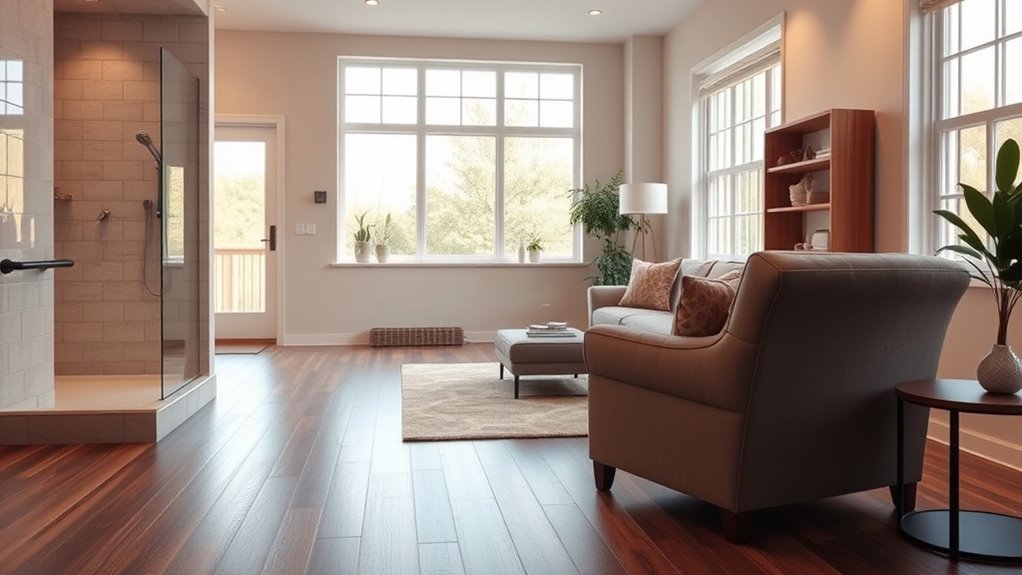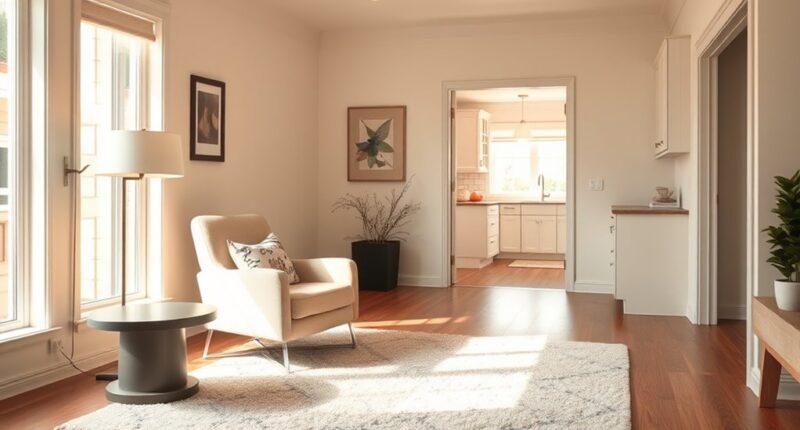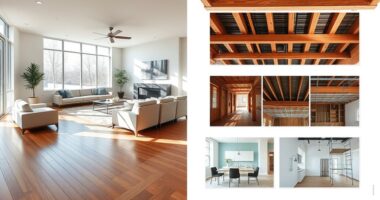remodeling for aging in place involves making practical, safe modifications to your home so you can stay independent longer. Focus on evaluating doorways, installing grab bars, and using non-slip flooring to prevent falls. Improve lighting, add motion-activated lights, and clear pathways to avoid hazards. Upgrading fixtures and widening doorways make everyday tasks easier. Small, thoughtful changes can markedly boost safety and comfort—continuing with these tips helps you create a home suited for the future.
Key Takeaways
- Assess current home layout for accessibility, including door widths and clutter, to identify necessary modifications.
- Install grab bars, non-slip flooring, and walk-in showers to enhance bathroom safety.
- Improve lighting with bright, well-placed fixtures and night lights to reduce fall risks.
- Widen doorways, add ramps, and replace thresholds to facilitate wheelchair or walker access.
- Rearrange or modify furniture and storage to promote easier movement and independence within the home.

Are you considering how to make your home safer and more comfortable as you age? It’s a smart thought, and taking proactive steps now can help you maintain your independence and enjoy your space longer. The key is to focus on practical modifications that address potential hazards while enhancing comfort. Start by evaluating your current living environment honestly. Are doorways wide enough for a walker or wheelchair? Are there rugs or clutter that could cause trips? Identifying these issues helps you prioritize which changes to implement first.
One of the most effective adjustments is installing grab bars in the bathroom. Water and slick surfaces make this area particularly risky, so adding sturdy bars near the shower, bathtub, and toilet provides extra support and stability. Consider replacing high-threshold showers with walk-in models or curbless showers, which eliminate the need to step over a ledge. Installing a shower seat can also be a lifesaver if you experience fatigue or balance issues. Smooth, non-slip flooring throughout the bathroom and other high-traffic areas reduces the risk of slips and falls; options like vinyl, cork, or textured tiles work well. Incorporating self-watering plant pots into your home can also improve your environment by adding greenery that requires minimal maintenance, contributing to a calming and pleasant atmosphere.
Lighting plays a vital role in safety and comfort. Bright, well-placed lighting minimizes shadows and makes navigation easier. Think about installing night lights in hallways, bathrooms, and bedrooms, especially if you wake frequently during the night. Switches should be easy to reach, and consider motion-activated lighting for added convenience. Clear pathways are essential—remove clutter, cords, or furniture that might obstruct your movement. Keeping walkways free from obstacles minimizes trip hazards and provides peace of mind.
Another practical step involves upgrading your fixtures to more accessible options. Lever-style door handles and faucet handles are easier to operate than traditional knobs, especially if you have arthritis or reduced hand strength. Widening doorways or installing pocket doors can make a significant difference if mobility becomes limited. Adding ramps at entry points instead of stairs helps maintain access without the need for strenuous steps. These modifications not only improve safety but also promote a sense of independence, making everyday tasks less stressful.
Finally, consider the overall layout of your home. Think about whether your current setup allows you to move easily between rooms or if rearranging furniture might help. Lowering shelves or countertops can make daily activities more manageable. Remember, these improvements don’t need to happen all at once—start with the most urgent issues and expand gradually. By thoughtfully remodeling your home with safety and comfort in mind, you’re investing in your well-being and ensuring your space remains a sanctuary for years to come.
Frequently Asked Questions
What Is the Average Cost of Aging-In-Place Remodels?
On average, aging-in-place remodels cost between $10,000 and $50,000, depending on the extent of modifications needed. You might spend less if you’re only making small adjustments like grab bars or better lighting, but more significant changes like bathroom redesigns or wheelchair-accessible entrances can be more costly. Planning a budget helps guarantee your renovations are safe, functional, and tailored to your evolving needs, giving you peace of mind at home.
How Long Does a Typical Aging-In-Place Renovation Take?
You’ll likely spend about six to eight weeks on an aging-in-place renovation, imagining your home transforming into a haven of safety and comfort. Throughout this process, your contractor will work diligently, installing grab bars, widening doorways, and updating flooring. You’ll see your space evolve step-by-step, ensuring each detail caters to your needs. Patience pays off, resulting in a personalized sanctuary that supports your independence for years to come.
Are There Government Grants Available for Aging-In-Place Modifications?
Yes, government grants are available to help you with aging-in-place modifications. Programs like the USDA’s Single Family Housing Repair Loans and Grants or local Medicaid waivers can provide financial assistance. You should check with your state’s housing authority or local agencies for specific grants, eligibility requirements, and application processes. These resources aim to make necessary home modifications affordable, ensuring your safety and independence as you age.
Can I Implement Aging-In-Place Features in a Rental Property?
Think of your rental as a houseplant needing gentle care. You can add aging-in-place features like grab bars or non-slip mats, but always check your lease or talk to your landlord first. Focus on temporary, non-invasive modifications that won’t damage walls or fixtures. Clear permission guarantees you can create a safer, more comfortable space without risking your security deposit or violating rental agreements.
What Are the Most Durable Materials for Aging-In-Place Renovations?
You should choose durable, non-slip materials like vinyl or tile for flooring, as they’re tough and safe. For countertops, opt for solid surface or quartz, which resist scratches and stains. Use stainless steel or reinforced materials for grab bars and fixtures to guarantee longevity. Prioritize waterproof, easy-to-clean surfaces in bathrooms and kitchens. These choices help create a safe, long-lasting environment that supports aging comfortably and reduces maintenance worries.
Conclusion
By remodeling your home for aging in place, you’re planting seeds of comfort and independence that will bloom over time. Think of your space as a sturdy tree, its branches offering shelter and safety as you grow older. With thoughtful updates, you create a sanctuary where every step feels secure, and every corner reflects your life’s journey. It’s not just about changing your home—it’s about nurturing a future where you can thrive, rooted in love and practicality.









